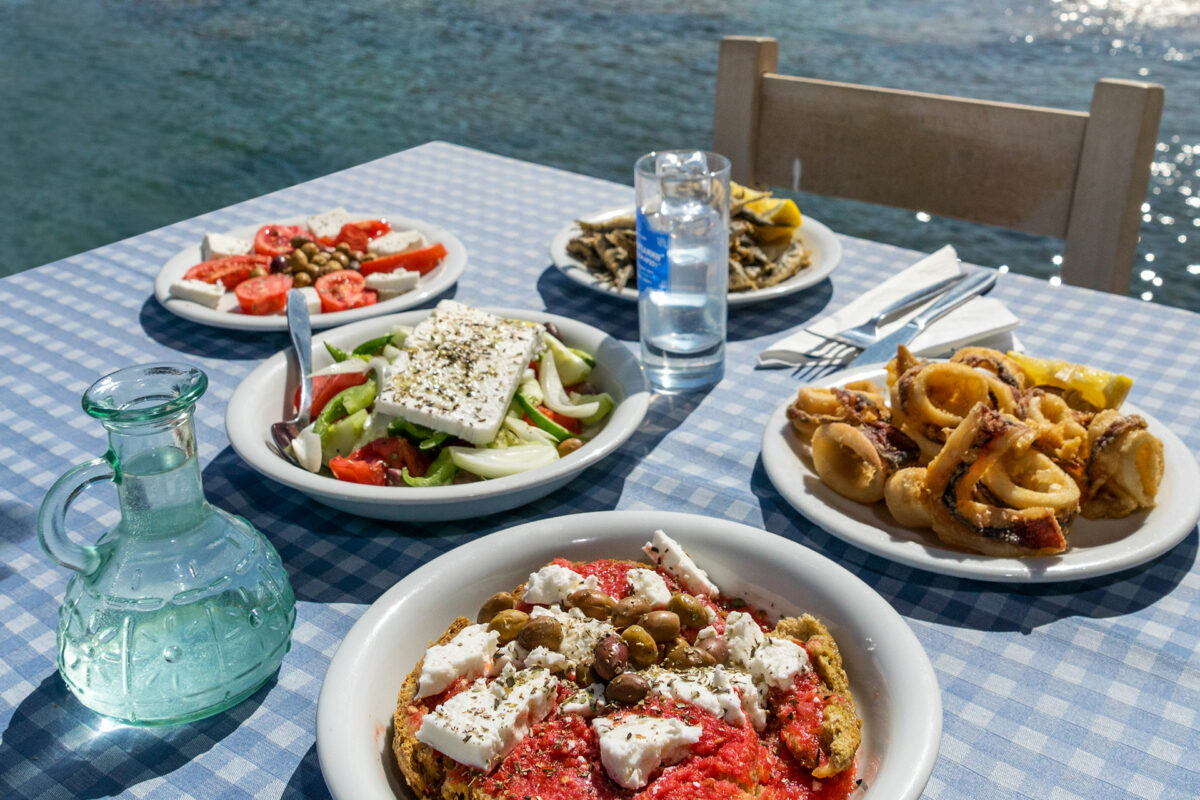
Wooden chairs, small tables covered in paper tablecloths, rustic interior decor, photos of dearly departed on the walls, and outside, the shade of a vine or an ancient tree are some of the common attributes of the Greek tavernas scattered around Crete.
At their origins, however, tavernas were even humbler than they appear today. Usually set up in any available room of a home, sometimes even a basement, they were communal hangouts for workers and laborers and even for common folk searching for an escape from the congested spaces of their homes. In these tavernas, people gathered to talk politics, chat or gossip about their neighbors, joke, and even sing at times.
The hosts served house wine invariably: a drink made for cheap and to last until the following season. The house wine (white or rose) was stored in rustic barrels sealed with Aleppo pine resin, which gave the beverage a unique aroma and taste – sometimes not the most desirable traits. This wine, popularly known as retsina (ρετσίνα), is the best-known traditional Greek wine still served in most of the tavernas today.
*If you want to drink retsina skipping the taverna experience, you can purchase it in local stores – both supermarkets and minimarkets sell it.
Retsina was at the heart of the Greek taverna experience back in the day, and it remains an essential contender to more refined wines today. Not only because it is considerably cheaper, but simply because its robust and unpolished taste is what taverna dining is all about: a down-to-earth, simple, unfussy experience meant to treasure the traditions preserved by the guardians of the food – the Greek yia-yias (grandmas).
Eat Like a Local in a Greek Taverna
Even though today’s tavernas cater to both international and local clientele, the dining experience remains authentic. If you want to eat like a local, consider ordering the house wine instead of beer or other drinks and pair it with meze.
When you sit to dine in a Greek taverna, don’t expect fancy plating and classy service. The servers will be attentive, happy to accommodate your special dietary needs, and always willing to recommend what’s fresh and what you should try that day. You should ask the staff what’s good and also if a yia-yia is in the kitchen. You’ll know your food is authentic if the answer is yes. Yia-yias are also why the taste of even the most common dish is so different from taverna to taverna. These Greek grandmothers have individual ancient recipes, treasured and passed along from generation to generation.
You will receive each dish as soon as the cook finishes preparing it, so don’t expect to get your order all at once. After they set the paper cloth or placemats in front of you, the waitstaff will bring you cold water, then return for your order. Bread appears first, followed by plates and cutlery, and drinks. Your food, with appetizers, is served first: dolmadakia, fava, taramosalata, tzatziki, Greek salad, and so on, depending on what you ordered.
Communal-style eating is a tradition all over Greece, and Crete is no exception to the rule. You share your food: that’s why the servers bring you clean plates and cutlery before delivering the dishes. You may be tempted to order a lot of appetizers – and it’s easy to get full on meze alone – but meat or fish mains are also delicious. These will arrive on individual plates, as you ordered them. However, consider that Greeks are generous with food, and they serve filling portions.
A good, filling example of dishes of meze for two would be: a portion of dolmades, one of tzatziki, one of taramosalata (salted and cured fish roe made into a creamy bread spread), a portion of fava (split yellow peas puree), a seasonal vegetable salad, and a portion of fish or meat of your choice with fries. Add to this spread a big carafe of retsina wine, and you’ll have a genuine Greek taverna dining experience.
As the dessert rounds up the meal, you’ll probably want to order something from the menu. Don’t. All Cretan tavernas bring dessert on the house, paired with raki or rakomelo. Depending on the season, you may get fresh fruit, ice cream, or traditional sweet pies or pastries.
Whatever you choose to order, do celebrate the honesty of this food rooted in local tradition and the atmosphere of the taverna, which strips us of excessive haughtiness and reminds us how to appreciate the simple joys of life.





